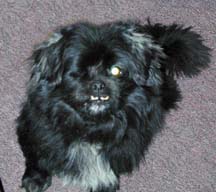Now for the trash parts. I suspect that most people receive a number of these fake
credit cards in their junk mail. The sender include them to catch those folks who feel
through the envelope before throwing out junk mail. It takes at least a few seconds to
realize this is not a real credit card. I recycle as much as I can so I go through
and remove these cards, they might jam up the recycling machines.
The other critical part is a used dryer sheet, the kind one puts in with laundry
when run through a dryer to prevent static buildup and to soften the laundry.
Once run through a few times, all the encapsulated chemicals have been released leaving
a strong peice of fabric behind.
The sheet was simply cut into quarter, each just slightly larger then the fake card.
The sheet quarter is simply secured as a cover over the card with some Duck-tape.
The dryer sheet will provide the tooth to a surface so that later work does not
simply pop off the card.
Now flipping the card right side up again, white glue (PVA) is used to stiffen the secures
the upper surface. This is a technique which is gaining popularity with model railroad fans.
It is know as "glue shell". It is not limited to such a minimal items, but can be used to form
hills, cliffs and even mountains. I use a small peice of card as a squeegee to forces the glue
through the fibers of the sheet and to spread it across the entire surface. Spreading the
glue over the edge and onto the exposed sheet on the bottom side will assure a good grip.
This can be messy, a sheet of waxed paper with prevent the card from becoming a permanent
part of you work bench.
Once the glue has dried, it can be painted with a soil colored paint.
I usually paint terrain with several different colors to avoid a too uniform color
coat. Once the paint has dried next step is to coat this surface with adhesive.
With the glue in place, the base is covered with coffee.
To simulate the rows of dirt often built up in gardens additional stripes of glue were added
over which more coffee can be sprinkled. The rows need not
be straight or very even. Few people take such care in laying out a garden patch.
Additional glue and coffee can be added until the contour
is to your liking.
To help root the garden patch to the surrounding terrain some scatter grass can be added to the
edges of the garden. This can also be use to breakup the very straight edges of the base card.
At this point several crops types could be added to the rows. A blob of glue and a pinch
of medium ground scatter, such as that sold be Woodland Scenics, can make a convincing garden
patch.
Here we see some vegetable patches. Note that the patch on the left is not as convincing as the color
of the crop is too close to that of the surrounding grass. The contrast of the other two examples
is much more convincing. One could also enhance the effect by making each row a different color.
This would give the effect of a home garden.
In the example that follows, we will use the plants formed from the Christmas tree as explained below.
The only item one really needs to buy is the plant stacks themselves. These I made from a
small cheep artificial Christmas tree. This one cost my $ 0.99 USD at a closeout store called
"Big Lots".
This type of decoration can be unwound to liberate long pipe cleaner like parts.
These are about a centimeter in diameter and made short lengths of plastic ribbon
wound between a pair of wires.
The material can cut into small lengths about the height of a man. Do not attempt to
cut the sections to the exact same length as this looks less natural.
Next I trim the tops and stems a bit.
I used Tacky Glue (PVA) to secure the plants. If one works quickly after the last build up of
the coffee into the rows a pits can be pressed into the
rows for each plant to accept the glue. Coating the stems part of the way up with glue also
helps to secure them to the base.
Here we see the terrain in use in a typical table top wargame. Some terrain items do not need to
be large to clearly convey their subject. I think this credit card size field works well
in suggesting an agricultural area.
The scale of the crops is clearer in this photo of a column of Her Majesty’s 1st Chinese Regiment
moving past the field.
To see more terrain items is use, check out the Battles page.
You may click on the following to return to the Master Terrain page.
You may click on the following to return to the Victorian Science Fiction page.
I hope to be able to add more latter.
Thank you for looking:
DyeHard
To head to my Home go to DyeHard's Home Page.


|Home
|What's New
|VSF
|My Figure Painting|
|LINKA
|Models
|E-mail|


This work is licensed under a Creative Commons License.